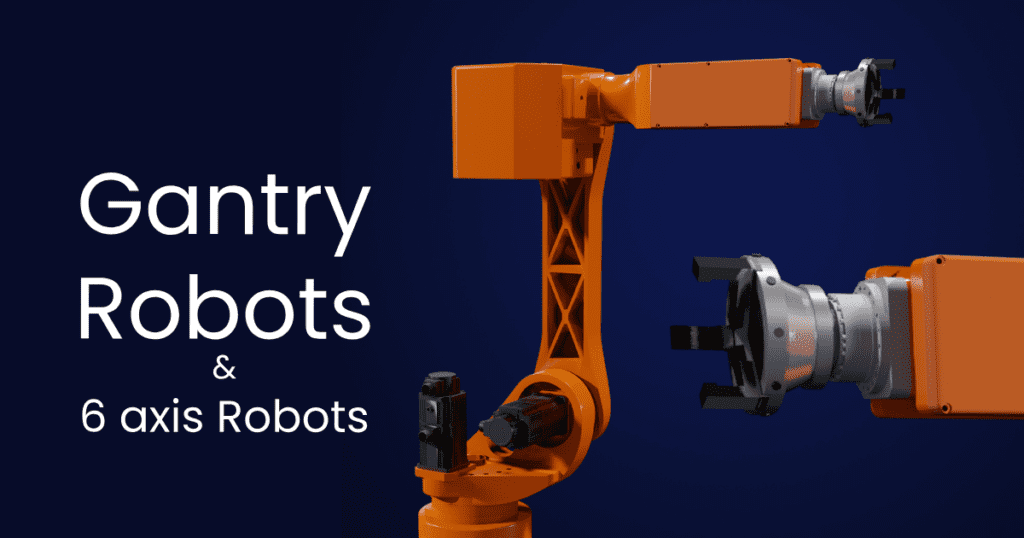
Gantry robots & 6-axis robots – Are they same or different??
6-axis/articulated robot
A six-axis robot, also known as an articulated robot, is a type of industrial robot with six degrees of freedom. These robots have rotational joints at each axis, allowing them to move in a wide range of motion like a human arm. The six axes typically include three rotational joints, often referred to as pitch, yaw, and roll, and three translational joints that enable movement in three-dimensional space. Six-axis robots are versatile and can perform complex tasks, making them suitable for applications such as assembly, welding, painting, and material handling.
So, before we learn what are the differences between them, 1st let’s understand why they often get confused?
Basically, at a glance, both gantry and 6-axis robots may appear quite similar, featuring articulated arms with joints and end-effectors. This visual resemblance can lead to initial confusion, along with their multi-axis movement capabilities, versatility in industrial automation, and overlapping applications led to further confusion. This confusion is exacerbated by a lack of familiarity with their distinctions, making it essential to clarify their unique roles and features. So, let’s dive into the differences between them.
Differences between Six-Axis and Gantry Robots?1.Scale: Gantry robots can easily scale; with the addition of a new axis according to the demand & this feature gives them an undeniable advantage over other industrial robot types, including the 6-axis robot.
2.Reach advantages: 6 axis robots can work in an envelope only max up to 3 meters, they can reach into tight spaces and perform tasks with a wide range of motion. Hence, they are suitable for applications requiring flexibility in various orientations and angles, whereas Gantry robot can have a larger work envelope of up to 30/40 meters and are suitable for applications requiring a large workspace. Gantry robots also cover more line and can handle a greater number of SKU’s.
3.Height advantages: The height of the gantry system can be customised as per product requirements whereas in a 6-axis robot increasing height is not an option, also its limited.
4.Less floor space: Gantry occupy less floor space than 6 axis robots. For gantry robot the floor space is mostly opened so can be utilised effectively. With advantage of reach and long-distance travel there is a flexibility of layout with higher SKUs management.
5.Less maintenance: As gantry is linear system it’s easy to maintain. Adding and removing an old motor and programming is easy in Gantry system which local technical teams can do.
6.Ease of integration: Gantry robots are relatively easier to integrate into manufacturing environments compared to articulated robots. Their fixed structure simplifies the setup process, reduces installation time, and minimizes the need for additional support structures. This can result in cost savings and quicker implementation.
7.High redundancy: Multiple gantries can operate on same span it offers high redundancy for operation. In case there is some issue in some gantry other will take over so that operation doesn’t hamper.
8.Applications: Gantries are ideal for applications such as material handling, pick-and-place operations, and tasks where linear movements are predominant, such as in CNC machining, 3D printing, and large-scale material handling, six-axis robots are ideal for welding, painting, assembly, and tasks requiring precision in small spaces.
The choice between a gantry robot and a 6-axis robot depends on your specific application requirements. Each type has its strengths and weaknesses, so the decision should be based on factors such as workspace requirements, payload, flexibility, precision, application type, budget etc. So, it’s essential to thoroughly assess the application’s requirements and available resources, to make an informed decision on whether a gantry robot or a 6-axis robot is the better fit for the project.
We at Anzo Controls provides such consultation required for your application needs & curate automation solutions for pick & place, palletizing, packaging, and material movement inside the warehouse. We provide hardware such as Gantry robots, Delta robots, Scara robots, 6-axis robots, conveying solutions along with software solutions such as MES & IoT solutions. For any inquiries regarding industrial automation, do reach out to us on info@anzocontrols.com
Subscribe Now
Don’t miss our future updates! Subscribe today!
Copyright © 2022 Anzo Controls | Designed by Creative Garage

